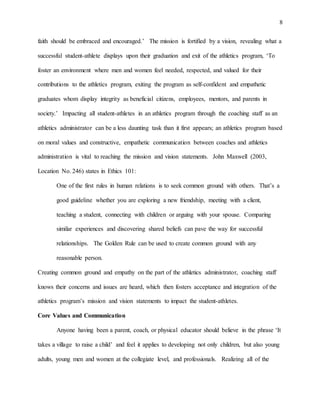This document presents a master's thesis project on directing athletics. The thesis examines how athletics administrators can influence the development of student-athletes' minds and bodies through the coaching staff.
The author argues that athletics administrators should develop coaching staffs by establishing a clear mission and values, focusing on transformational coaching styles, and ensuring coaches receive ongoing training. The thesis also describes research conducted on divorce rates among high school football coaches and how a coach's personal life can impact their work with students. The goal is for athletics administrators to guide coaches in a way that enhances student-athletes' mental, physical, and character development.










































































![74
Cynarski, Wojiech, (2014). Ido Movement for Culture. Journal of Martial Arts Anthropology,
14(1), 1-10. Retrieved July 10, 2014, from SportDiscus database.
Denison, J., Avner, Z, (2011). Positive Coaching: Ethical Practices for Athlete Development.
Quest, (00336297) 63(2), 209. Retrieved July 10, 2014, from SportDiscus database.
DiColo, J. (2015, Winter). Booster clubs: Lover them or hate them. Interscholastic
Athletic Administration, 42(2), 20-21.
DiColo, J. & Mitzel, L. (2012, Winter). ADvice: Coaching interview processes. Interscholastic
Athletic Administration, 39(2), 20-23.
Duggan, T. (2013). Erin Cox Confesses to drinking at underage party that gained National
Attention-The history of a bogus media story that never happened. The Valley Patriot
Retrieved July 8, 2014, from
http://valleypatriot.com/erin-cox-confesses-to-drinking-at-underage-party-that-gained-
national-attention-the-history-of-a-bogus-media-story-that-never-happened/
Ehrmann, J. (2011). InsideOut coaching: How sports can transform lives. New York, NY:
Simon & Schuster.
Evers, J. (2015, Fall). Making the Transition from Coaching to Athletic Administration.
Interscholastic Athletic Administration, 42(1),18-19.
Gambetta, V. (2007). Athletic development: The art & science of functional sports
conditioning. Champaign, IL: Human Kinetics.
Lumpkin, A., Stoll, S. K., & Beller, J. M. (2003) Sport ethics applications for fair play. (3rd ed.).
New York, NY: McGraw-Hill.
Martens, Rainer. (2012). Successful coaching. (4th Edition). Champaign, IL. Human Kinetics
[Kindle Version]. Retrieved from Amazon.com.](https://image.slidesharecdn.com/48130a65-d7c2-42d3-9d7c-f14b8a720694-160611195320/85/Fowler-Kenneth-595-Forkum-Spring-16-75-320.jpg)
![75
Marx, J. (2003). Season of life: A football star, a boy, a journey to manhood. New York, NY:
Simon & Schuster.
Maxwell, J.C. (2003). Ethics 101 what every leader needs to know. New York, NY: Center
Street [Kindle Version]. Retrieved from Amazon.com.
May, G., Reinkens, C. (2011). Coaches’ duty of care revisited. BC Coach’s Perspective,
Summer 2011, 10.
McCombs, C. (2013). 80 Badass Quotes About Training. Retrieved March 14, 2015,
from Chris McCombs.Net: http://chrismccombs.net/80-quotes-about-training/
McNamee, M. (1998). Ethics & Sport. Retrieved July 8, 2014, from SportDiscus database.
NIAAA Publications Committee. (2008, Winter). Establishing and Maintaining an Athletic
Chain of Command. Interscholastic Athletic Administration, 35(2),20-21.
NIAAA Publications Committee. (2016). Game Plan: Effective strategies for building
better athletic schedules. Interscholastic Athletic Administration, 42(3),21.
Smith, J. M. (2013). The sons of westwood: John wooden, UCLA, and the dynasty that
changed college basketball. Urbana: University of Illinois Press.
Wendler, J. (2009). 5-3-1: The Simplest and Most Effective Training System to Increase Raw
Strength. London, OH: Jim Wendler.
Willenbrock, P. (2015). Developing a Coach Evaluation Rubric. Interscholastic
Athletic Administration, 41(4),16-19.
Williams, J. (2010). Applied sport psychology: Personal growth to peak performance. New
York, NY: The McGraw-Hill Companies, Inc.](https://image.slidesharecdn.com/48130a65-d7c2-42d3-9d7c-f14b8a720694-160611195320/85/Fowler-Kenneth-595-Forkum-Spring-16-76-320.jpg)


























































![134
Players
Our players will build their self-confidence by creating a goal setting plan with 2
outcome goals for each of the 3 phases of the year (pre-season[June to August], season,
off-season [December to May]), but the players will understand the importance of
succeeding at their process and performance goals to improve their self-worth.
Our players will learn how to maintain optimism when faced with daunting tasks by
using imagery (both present and reflective) and self-talk to overcome adversity.
Our players will be able to deal with stress both on and off the field through the use of
relaxation and meditation, along with breathing techniques taught by the staff.
Team
The team will come up with 1 outcome goal related to academic performance and 1
outcome goal related to displaying character on and off the field by working in small
groups then presenting to the team for a vote.
The team will demonstrate caring for one another through the use of positive
reinforcement by becoming conscious of their verbal and nonverbal communication.
4. List the Foundational Skills You Will Seek to Enhance in your MTP
Achievement Drive
Given the history of losing associated with Northeast High School football, the players
need to have a common outcome to focus on. There are many obstacles that present
themselves playing the big school schedule that we do, since we are a small school.
With a common vision the players will be able to unite with purpose and positivity.](https://image.slidesharecdn.com/48130a65-d7c2-42d3-9d7c-f14b8a720694-160611195320/85/Fowler-Kenneth-595-Forkum-Spring-16-135-320.jpg)









































![176
Outcome Goals
– The overall result of your goal
• Improve my bench press by 30 pounds in 4 months
Performance Goals
– Assessing performance or your goal on your way towards your goal
• Every 5 weeks I should improve my bench by 10 pounds
Process Goals
– Procedure you will go through to achieve your goal
• (Monday and Wednesday core lifts will include Flat Bench and Incline Bench
respectively at the weekly workout as follows until the testing week: 4x4(last set 4+), 5x5
(last set 5+), [5,4,3,2,1+], [10,8,6+] this will be repeated in a 4 week cycle)Monday and
Wednesday supplemental lifts will include Dumbbell Incline Press, Dumbbell Bent Arm
Pullover, and Arnold Press on Mondays, while Wednesdays will include Cable
Crossovers, Dumbbell Flies, Arnold Press, Dumbbell Thrusters with the weekly workout
as follows until the testing week: 3x8, [10,8,8+], [10,10,6+], [12,10,8,6+], 3x10 this will
be cycled until the testing week.
Active / Dynamic Warm-up and Mobility Routine
The active/dynamic routine must be specific to the outcome of training and that is why
the warm-up before the lifting program differs from the warm-up before speed/agility training
and pre-game. Gambetta (2007, p. 253) reminds dynamic and strength training warm-ups
function as a mobility warm-up as well due to the cross behind switches and stick work
respectively.
A complete and effective warm-up should be in concert with the goal of the workout. It
should be progressive in that it builds in intensity in a crescendo like manner. It must be
active and dynamic, not passive and static.](https://image.slidesharecdn.com/48130a65-d7c2-42d3-9d7c-f14b8a720694-160611195320/85/Fowler-Kenneth-595-Forkum-Spring-16-177-320.jpg)
































